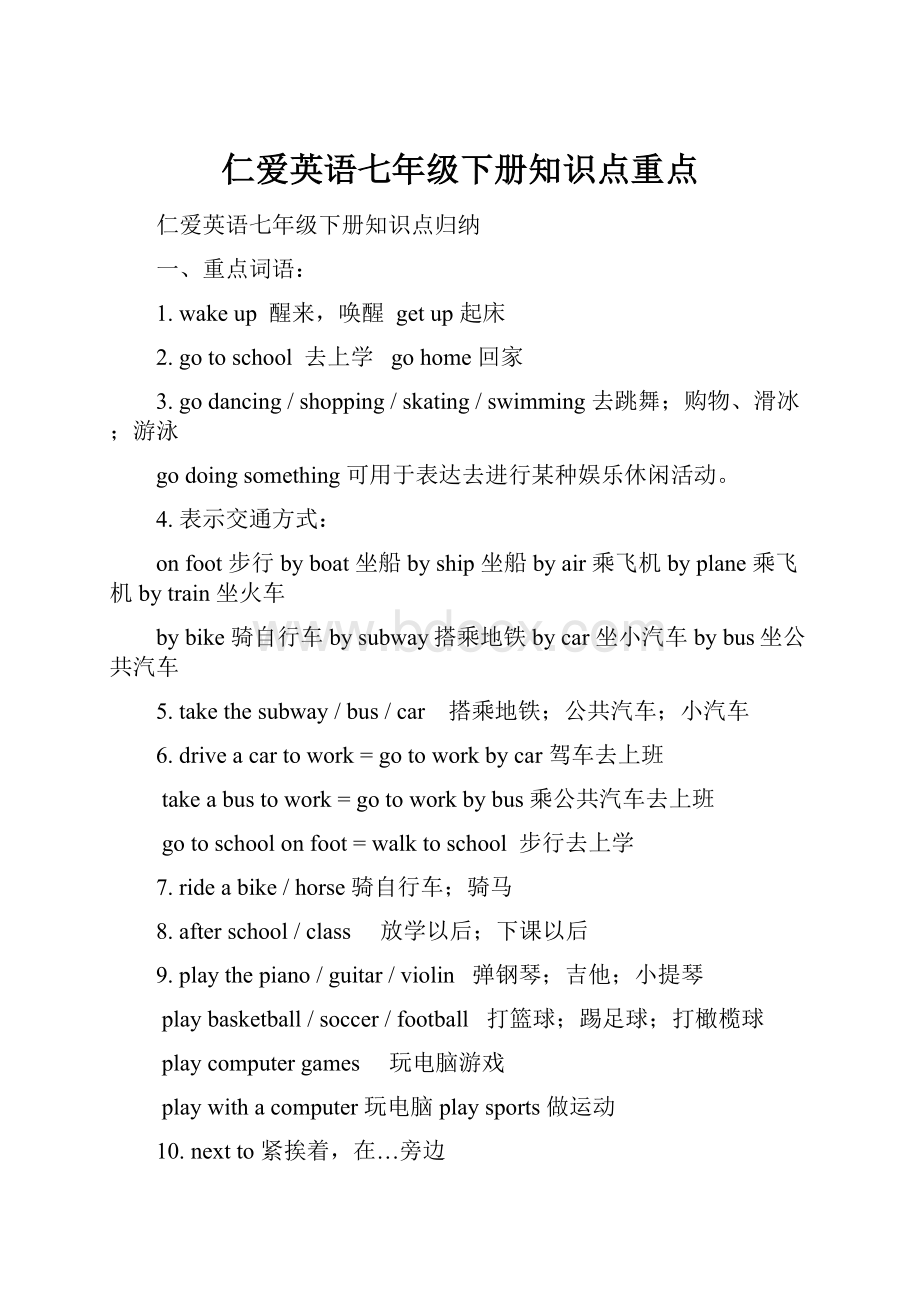 仁爱英语七年级下册知识点重点.docx
仁爱英语七年级下册知识点重点.docx
- 文档编号:27651784
- 上传时间:2023-07-03
- 格式:DOCX
- 页数:37
- 大小:51.53KB
仁爱英语七年级下册知识点重点.docx
《仁爱英语七年级下册知识点重点.docx》由会员分享,可在线阅读,更多相关《仁爱英语七年级下册知识点重点.docx(37页珍藏版)》请在冰豆网上搜索。

仁爱英语七年级下册知识点重点
仁爱英语七年级下册知识点归纳
一、重点词语:
1.wakeup醒来,唤醒getup起床
2.gotoschool去上学gohome回家
3.godancing/shopping/skating/swimming去跳舞;购物、滑冰;游泳
godoingsomething可用于表达去进行某种娱乐休闲活动。
4.表示交通方式:
onfoot步行byboat坐船byship坐船byair乘飞机byplane乘飞机bytrain坐火车
bybike骑自行车bysubway搭乘地铁bycar坐小汽车bybus坐公共汽车
5.takethesubway/bus/car搭乘地铁;公共汽车;小汽车
6.driveacartowork=gotoworkbycar驾车去上班
takeabustowork=gotoworkbybus乘公共汽车去上班
gotoschoolonfoot=walktoschool步行去上学
7.rideabike/horse骑自行车;骑马
8.afterschool/class放学以后;下课以后
9.playthepiano/guitar/violin弹钢琴;吉他;小提琴
playbasketball/soccer/football打篮球;踢足球;打橄榄球
playcomputergames玩电脑游戏
playwithacomputer玩电脑playsports做运动
10.nextto紧挨着,在…旁边
11.onweekdays在工作日atweekends在周末
12.havebreakfast/lunch/supper/dinner/meals吃早餐;中餐;晚餐;正餐;一日三餐
haveclasses/lessons/ameeting上课;上课;开会
13.watchTV/movies/games/theanimals看电视;电影;比赛;动物
readnovels/newspapers/books看小说;报纸;书
14.washone’sface/clothes洗脸;衣服
15.反义词:
up–down,early–late近义词:
quickly–fast
getupearly早起belatefor迟到
16表示建筑物(尤其学校建筑物):
ontheplayground在操场atschool/home/table学校;家里;桌旁
inacomputerroom/teachers’office/classroombuilding/gym/library/lab/canteen
在电脑室;教师办公室;教学楼;体操馆;图书馆;实验室;食堂
17.aroundsixo’clock=ataboutsixo’clock大约在六点
18.频率副词:
never,seldom,sometimes,often,usually,always
重点详解
1.Ialwayscometoschoolbybus.
by+交通工具名称,表示使用某种交通方式,中间不加限定词,如果交通工具前有a,the,my等限定词,就不能用by,而是用in或是on.
onthetrain=bytrainonhisbike=bybikeinmycar=bycar.
巧辩异同 onfoot与walkonfoot“走路”,是介词短语,不能作谓语,只作方式状语,位于句末。
walk“走路”,是动词,可以作谓语。
goto…onfoot=walktoIoftengotoschoolonfoot.=Ioftenwalktoschool.
同样,goto….bybike=rideabiketogoto….bycar=driveacarto
goto…byplane=flytogoto…bybus=takeabusto
2.Comeon!
It’stimeforclass.comeon“快点,加油,来吧”。
It’stimeforsth.“该做某事了”,与It’stimetodosth.意思一样。
3.look的短语lookthesame看起来一样 looklike看起来像……
lookfor寻找lookafter照顾
4.domyhomeworkatschool在学校做作业
doone’shomework做家庭作业(注意:
one’s要随主语的变化而变化,常用形容词性物主代词my,your,their,our,his,her等)。
5wewanttoknowabouttheschoollifeofAmericanstudents.我们想了解一下美国学生的学校生活。
knowabout“了解,知道关于…”。
6巧辩异同 afew与fewafew“一些”,few“很少,几乎没有”,修饰可数名词。
alittle与little alittle“一些”,little“很少,几乎没有”,修饰不可数名词。
7Theyoftenplaybasketballorsoccer,goswimmingandsoon.
goswimming去游泳 andsoon“等等”,表示还有很多。
拓展go+v.-ing表示去做某事,类似的有:
gofishing去钓鱼goshopping去买东西goboating去划船goskating去滑冰
8Howoftendoyougotothelibrary?
你多久去一次图书馆?
howoften“多久一次”,问频率。
答语常用频度副词never,always,often等或单位时间内的次数onceaweek一周一次twiceamonth每月两次threetimesayear每年三次
语法讲解一般现在时
一般现在时:
1.区别含有be动词和行为动词的肯定句式。
Iamathome.√Istayathome.√Iamstayathome.×Shestayathome.×
2.一般疑问句、否定句表达的不同方式:
Areyouathome?
Doyoustayathome?
Doesshestayathome?
Yes,Iam.No,Iamnot.Yes,Ido.No,Idon’t.Yes,shedoes.No,shedoesn’t.
Iamnotathome.Idon’tstayathome.Shedoesn’tstayathome.
3.主语为第三人称单数时,谓语行为动词的变化。
SheplayscomputergamesonSundays.
ShestudiesEnglisheverymorning.
Shegoestoschoolonweekdays.
Shehasbreakfastat6:
45.
一般现在时表示:
(1)现在所处的状态。
Janeisatschool.
(2)经常或习惯性的动作。
Ioftengotoschoolbybus.
(3)主语具备的性格和能力。
Helikesplayingfootball.
(4)客观真理。
Theearthgoesroundthesun.太阳围绕地球转。
常用的时间状语:
often,always,usually,sometimes,everyday等等。
行为动词的一般现在时,助动词是do/don’t和does/doesn’t.当主语是第一、二人称和所有复数形式时,行为动词用原形。
肯定式:
Igotoschoolonfoot.否定式:
Idon’tgotoschoolonfoot.
疑问式:
Doyougotoschoolonfoot?
—Yes,Ido.—No,Idon’t.
当主语是第三人称单数时,动词用第三人称单数形式,在词尾加-s或-es。
肯定式:
Hegoestoworkbybus.否定式:
Hedoesn’tgotoworkbybus.
疑问式:
Doeshegotoworkbybus?
—Yes,hedoes.—No,hedoesn’t.
Topic2
一、重点词语:
1.学科名词:
政治
语文
数学
英语
历史
地理
生物
音乐
体育
美术
politics
Chinese
math
English
history
geography
biology
music
P.E.
Art
2.一周七天名词:
星期日
星期一
星期二
星期三
星期四
星期五
星期六
Sunday
Monday
Tuesday
Wednesday
Thursday
Friday
Saturday
3.swimmingpool游泳池
4.listentomusic听音乐writeletters写信goroller-skating滑滑轮
goshopping去购物haveanEnglishclass上英语课gotothepark去公园
meetfriends会见朋友drawpictures画画playsports做运动
watchTV看电视playcomputergames玩电脑游戏playsoccer踢足球
workonmathproblems解答数学题takeexercises做运动
learnaboutthepast学习历史learnhowtoreadandwriteinChinese学着用中文读写
playballgameswithmyclassmates和我的同班同学玩球类游戏
5.begoodat=dowellin擅长于…IamgoodatEnglish.=IdowellinEnglish.
6.bedifferentfrom与…不同thesameas与…相同
7.dooutdooractivities进行户外活动
8.everyweek每周eachday=everyday每天threetimesaweek每周三次
9.doone’sbest尽力去做某事doone’shomework做家作
10.likedoingsomething=lovedoingsomething喜欢做某事
hatedoingsomething讨厌做某事
11.athalfpastsix=atthirtypastsix=atsixthirty六点半atseveno’clock=atseven在七点
atfivefifteen=atfifteenpastfive=ataquarterpastfive五点十五分
atfifteentoten=ataquartertoten=atnineforty-five九点四十五分
12.foralittlewhile就一会儿13.astudentofGradeOne一年级的学生
14.eatout出去吃,下馆子15.gethome到家
重点语法 现在进行时态。
重点句型 Whatareyoudoing?
Heiscleaningthedormitory.
Areyoudoingyourhomework?
Yes,Iam./No,Iamnot.
HowlongcanIkeepthem?
Twoweeks.
重点详解
1atthemoment“此刻,现在”,相当于now.
2巧辩异同 gotosleep与gotobed
gotobed“上床”“就寝”Ioftengotobedatten.
gotosleep“入睡”“睡着”LastnightIwenttosleepattwoo’clock.
3巧辩异同some,afew与alittle “一些,有些”三者都修饰名词。
some既可以修饰可数名词又可以修饰不可数名词。
Wewantsomeapplesandsomewater.
afew用在可数名词复数之前,alittle用在不可数名词之前。
Thereareafewbooksandalittlewaterintheclassroom.
4与how相关的短语 howoften多常 howmany多少howmuch多少钱 howold多大
5Andyoumustreturnthemontime.你必须按时归还它们。
Return意为“归还,回归”
returnsth.tosb.把某物归还某人=givebacksth.tosb.
returnto“回到…”,相当于comebackto…
6Mariaandagirlaretalkingatthelostandfound.
talk“交谈”,常用的短语talkto/withsb.“与某人交谈”
巧辩异同talk,say,speak与tell
(1)talk“交谈”,表示通过谈话方式交换意见、消息等。
(2)speak“说话”,强调开口发声,后常接某种语言。
(3)say“说”,强调所说的话的内容。
(4)tell“告诉”,有时兼含“嘱咐”“命令”等。
tellatruth说真话,tellalie说谎,tellastory讲故事等固定搭配。
7.Ican’tfindmypurseandIamlookingforit.lookfor“寻找”,强调寻找的过程;find“找到”强调找的结果。
8.look(at),see与read look(at)指看的动作,see指看的结果,read常指看书、看报纸等。
9.Herearesomephotosofhis.这有他的一些照片。
photosofhis是双重所有格。
his是名词性物主代词,后还可以接名词所有格。
afriendofmine我的一个朋友aclassmateofmybrother’s我弟弟的一个同学
10.Ialsowanttogothereoneday.我也希望有一天到那儿。
also意为“也”,常用于be动词和情态动词后面,实义动词的前面。
巧辩异同also与too also放在句中,too用于句末。
语法讲解现在进行时
1.现在进行时表示:
现在正在进行或发生的动作。
2.常用的时间状语:
now,atthemoment,look,listen等。
3.谓语动词构成:
be(am/is/are)+v.-ing形式。
4.现在进行时态的肯定、否定和疑问式。
(1)肯定式:
Iamrunning.Youarerunning.He/Sheisrunning.
(2)否定式:
I’mnotrunning.Youaren’trunning.He/Sheisn’trunning.
(3)一般疑问句及回答:
—Areyourunning?
—Yes,Iam./—No,Iamnot.
—Ishe/sherunning?
—Yes,he/sheis./—No.he/sheisn’t.
Topic3
重点语法 一般现在时和现在进行时的使用和异同。
重点句型 Whatdayistitoday?
It’sWednesday.
Whydoyoulikeit?
it’seasyandinteresting.
Whatclassaretheyhaving?
Theyarehavingamusicclass.
重点详解
1询问星期几用Whatday…?
回答:
It’sWednesday/Sunday…。
与特殊疑问句词what有关的短语:
whatclass什么班whatcolor什么颜色 whattime几点whatdate几号(日期)
2Howmanylessonsdoeshehaveeveryweekday?
Howmany+可数名词的复数形式;Howmuch+不可数名词。
3一个星期的第一天是Sunday,在星期几前用介词on, 在具体点钟前用at.
4learningaboutthepast了解过去 learnabout了解
拓展 learnfrom向……学习 learnbyoneself自学
5Whatdoyouthinkof…?
=Howdoyoulike…?
你认为……怎么样?
6—Why?
—Becauseit’sinteresting.用why提问必须用because回答。
7Whichsubjectdoyoulikebest?
你最喜欢什么科目?
likebest最喜欢,可用favorite“特别喜爱的”转换。
MyfavoritefoodisJiaozi.=Ilikejiaozibest.
8befriendlytosb.对某人友好
9Icanlearnalotfromit.我能从中学到很多东西。
(1)learn…from“从……学习”。
(2)alot=much“许多”,后接宾语时要说alotof也可以表示“非常,十分”。
Unit6Topic1
重点语法 Therebe句型和方位介词短语。
重点句型 Therearetwobedroomsandaasmallstudy.
Thereisalamp,acomputer,somebooksandsoon.
—Isthereacomputerinyourstudy?
—Yes,thereis.
Don'tputthemhere.Putthemaway.
重点讲解
1It’sonthesecondfloor.
在哪一层楼,用介词on。
on表示在……上面。
second是序数词,前面要用定冠词the,意为第二(的)。
巧辩异同two与second
two是基数词,second是序数词,“第二”或“第二的”,指排列顺序。
2in在……里面,是方位介词。
intheboxintheclassroom
Isthere…?
表示某地存在……吗?
其肯定回答是:
Yes,thereis.否定回答No,thereisn’t.它的复数形式为Arethere…?
其肯定回答是:
Yes,thereare.否定回答No,therearen’t.
3巧辩异同therebe与have
(1)therebe“有”,指(某地)存在“有”。
(2)have“有”,指人或某物“拥有”。
Theisadoginthepicture.Thedoghastwobigeyes.
注:
therebe遵循就近原则。
be用is还是are,取决于离该动词最近的那个名词。
如果该名词是单数或不可数名词就用is,如果是复数就用are。
4havealook看看。
后面接名词时要用at.如havealookatyourwatch.
5talkabout“谈论,议论”,后接名词或动名词。
talkwith/to“与某人交谈”
6用来询问某地有某物,其结构为:
What’s+介词短语,回答时应用therebe句型。
7playwith“和……玩耍”,“玩” playwithsb. “与某人一起玩”
8putaway把……放好
9lookafter“保管,照顾”,相当于takecareof.
lookat看……looklike看起来像……lookfor寻找lookthesame看起来一样
10巧辩异同inthetree与onthetree
(1)inthetree指外来物体在树上。
(2)onthetree树木本身长出来的花、树叶等。
11巧辩异同likedoing与liketodo
likedoing表示经经常性或习惯性的兴趣、爱好。
与lovedoing相似。
liketodo表示偶尔的、一次性的喜欢。
与lovetodo相似。
12I’mverygladtogetaletterfromyou.我很高兴收到你的来信。
getaletterfromsb.收到某人的来信=hearfromsb.
Topic2
重点语法 Therebe句型Wh-questions
重点句型 What’syourhomelike?
What’sthematter?
Sorry,Ican’thearyou.I’llgetsomeonetocheckitrightnow.
Thereissomethingwrongwithmykitchenfan.
重点讲解
1housewiththreebedrooms.有三间卧室的房子。
with“有,带有”。
With还可以意为“和(某人/某物)在一起”
2apartmentforafamilyoftwo.适合两口之家的公寓。
(1)for表示“给……”表示目的或功能。
后接物主代词或名词,但通常带’s.或者后接表示无生命物体的
- 配套讲稿:
如PPT文件的首页显示word图标,表示该PPT已包含配套word讲稿。双击word图标可打开word文档。
- 特殊限制:
部分文档作品中含有的国旗、国徽等图片,仅作为作品整体效果示例展示,禁止商用。设计者仅对作品中独创性部分享有著作权。
- 关 键 词:
- 仁爱 英语 年级 下册 知识点 重点
 冰豆网所有资源均是用户自行上传分享,仅供网友学习交流,未经上传用户书面授权,请勿作他用。
冰豆网所有资源均是用户自行上传分享,仅供网友学习交流,未经上传用户书面授权,请勿作他用。


 《贝的故事》教案4.docx
《贝的故事》教案4.docx
